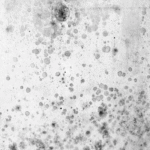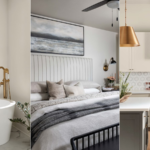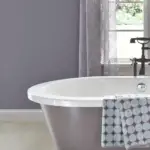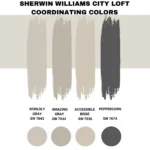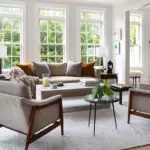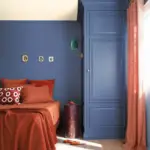Colors evoke emotions and set the tone for a space. A calming shade can transform your bedroom into a sanctuary, while a vibrant one may create excitement. Understanding the emotional triggers of colors can help you choose hues that resonate with your lifestyle and preferences.
- The Psychology of Colors: How They Influence Mood
- Factors to Consider When Choosing Bedroom Paint Colors
- Neutral Shades: Timeless and Versatile
- Exploring the Calming Effects of Blue
- Green: A Healing and Refreshing Choice
- Purple: A Color of Luxury and Calm
- Colors to Avoid in the Bedroom
- How to Use Accent Walls Effectively
- The Role of Lighting in Paint Selection
- Testing Paint Colors Before Committing
- Coordinating Paint Colors with Bedroom Furniture
- Creating a Cohesive Color Scheme
- Popular Bedroom Paint Color Trends
- Painting Techniques to Elevate Your Bedroom Design
- DIY Bedroom Painting Tips for Beginners
- Understanding Paint Costs and Coverage
- Final Tips for a Perfectly Painted Bedroom
- Wrapping Up: Finding Your Perfect Bedroom Color
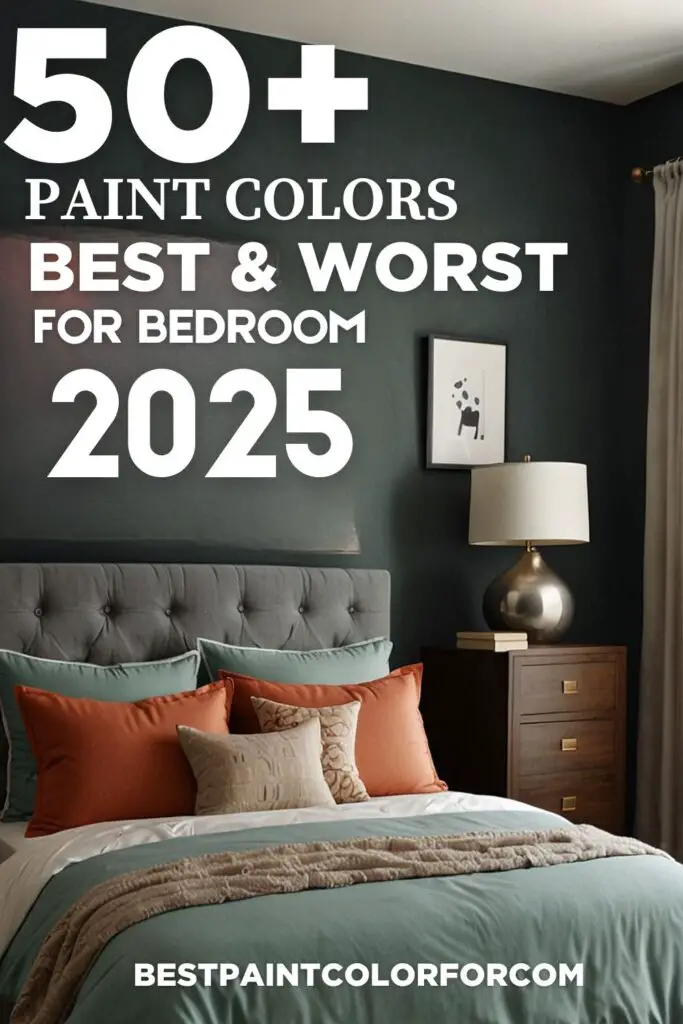
How Color Influences Sleep Quality
Research shows that certain colors, like blue and green, promote better sleep by calming the nervous system. In contrast, bright colors like red can overstimulate the brain, leading to restlessness. Choose shades that encourage a restful environment for optimal relaxation.
Reflecting Your Personality in Your Bedroom Colors

Pro Grade Paint Roller Kit, Brush & Roller for Professionals & Homeowners
Perfect for smooth finishes on your interior walls. Ideal for home improvement enthusiasts!
Buy Now on AmazonYour bedroom should be a reflection of your personality. If you’re adventurous, you might gravitate toward bold shades like teal or purple. For those who prefer simplicity, neutral tones like beige or cream might be more appealing.
The Role of Colors in Interior Design Trends
Modern interior design emphasizes the importance of cohesive color palettes. Neutral tones remain popular for their timeless appeal, while bolder choices like deep green or moody blue offer a contemporary edge.
The Connection Between Color and Overall Room Aesthetics
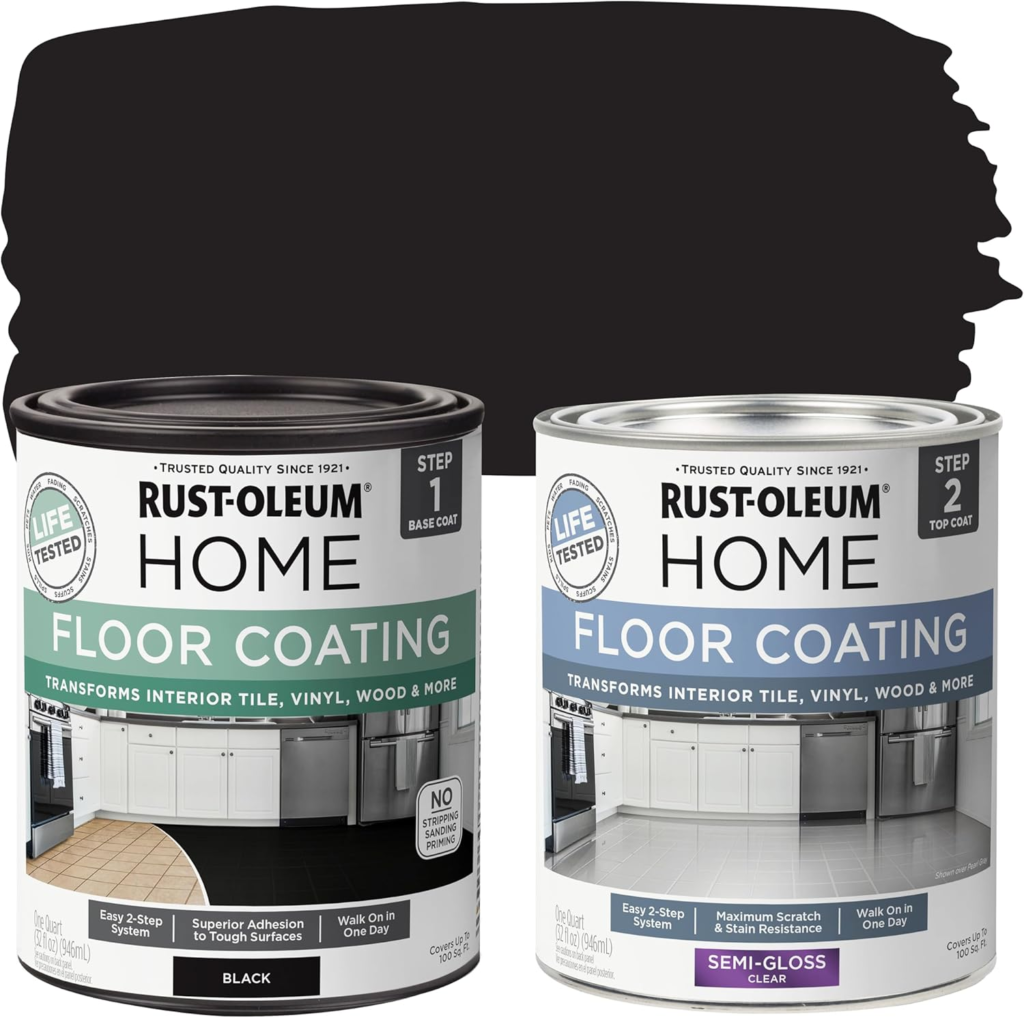
Rust-Oleum 367605 Home Interior Floor Coating Kit, Semi-Gloss Black
Ideal for updating outdated flooring at a fraction of the cost of replacement and adheres without stripping, sanding or priming.
Buy Now on AmazonThe color of your walls serves as the backdrop for your furniture, décor, and accessories. A poorly chosen shade can clash with the overall design, while a thoughtfully selected one can enhance every element of your space.
The Psychology of Colors: How They Influence Mood
Understanding the Basics of Color Psychology
Colors influence how we feel and behave. Warm tones like yellow and orange energize, while cool tones like blue and green calm and soothe. This fundamental knowledge helps in selecting bedroom hues that support relaxation.
Warm Colors and Their Effects on Mood
Warm colors evoke feelings of warmth and excitement. However, too much warmth in a bedroom can feel overwhelming. Pair warm tones with neutral accents to balance their intensity.
The Power of Cool Colors in Creating Tranquility
Cool tones, such as blues and greens, are linked to calmness and serenity. These shades are ideal for bedrooms, as they encourage relaxation and a peaceful night’s sleep.
How Neutral Tones Support Emotional Balance
Neutral shades like white, gray, and beige provide a sense of stability and simplicity. They are perfect for individuals who want a clean, understated look that doesn’t overpower their senses.
Incorporating Color Psychology into Bedroom Décor
Beyond wall colors, consider how your furniture, bedding, and accents contribute to the overall mood. Coordinating colors across elements can amplify the psychological effects of your chosen palette.
Factors to Consider When Choosing Bedroom Paint Colors
The Importance of Natural Lighting
Natural light changes throughout the day, altering how colors appear. South-facing rooms get warm light that enhances yellows and oranges, while north-facing rooms benefit from cool tones.
The Influence of Artificial Lighting on Color Perception
Artificial light can make colors appear warmer or cooler. Incandescent bulbs enhance warm tones, while LED lights often bring out cooler hues. Consider your lighting setup when testing paint samples.
Balancing Room Size with Color Choices
Light colors can make a small bedroom appear larger, while dark tones create a cozy, intimate feel in spacious rooms. Evaluate your room’s dimensions before settling on a shade.
Matching Paint Colors to Existing Décor
Take stock of your furniture, rugs, and artwork. A cohesive look can be achieved by selecting paint colors that complement your existing décor.
Considering Your Personal Preferences and Lifestyle
Your bedroom is a personal retreat, so choose a color that makes you happy. Whether you prefer bold, dramatic tones or soft, calming hues, your choice should align with your personality and daily needs.
Neutral Shades: Timeless and Versatile
Exploring the Versatility of White
White is a classic choice that offers a blank canvas for creativity. Its simplicity allows you to play with colorful décor and accessories.
Shades of Gray: The Modern Neutral
Gray is a sophisticated option that works well in both modern and traditional bedrooms. Its versatility spans from light silver tones to deep charcoal shades.
Beige and Cream: Soft and Subtle Options
These warm neutrals exude coziness and blend seamlessly with almost any décor style. They’re perfect for creating a welcoming and comfortable atmosphere.
Introducing Greige: A Fusion of Gray and Beige
Greige combines the best of both worlds, offering a contemporary yet warm aesthetic. It’s an excellent choice for those who want a modern neutral.
How to Enhance Neutral Tones with Décor
Add depth to neutral walls with textured fabrics, bold artwork, or colorful accents. These elements prevent the space from feeling bland while maintaining its calm vibe.
Exploring the Calming Effects of Blue
Light Blue: A Sky-Inspired Serenity
Pale blue tones mimic the open sky, creating a light and airy feel in your bedroom. This shade is ideal for small spaces, as it makes the room feel larger.
Deep Navy: A Dramatic and Cozy Option
Navy blue adds a touch of elegance and drama to any bedroom. Pair it with white or gold accents for a luxurious look.
Teal and Turquoise: A Vibrant Twist on Traditional Blue
These shades infuse energy and creativity into your bedroom while maintaining a calming undertone. They’re perfect for those who want a unique take on blue.
Using Blue Accents for a Coastal Vibe
Incorporate blue in accent pieces like pillows, rugs, or curtains for a beach-inspired design. This creates a fresh and breezy ambiance.
Combining Blue with Other Colors for Contrast
Blue pairs beautifully with neutrals, greens, and even yellows. Use complementary colors to add depth and interest to your bedroom.
Here’s the continuation of the guide, following the structure with expanded sections for all 20 headlines:
Green: A Healing and Refreshing Choice
Sage Green: Subtle and Sophisticated
Sage green provides a muted, earthy tone that exudes tranquility. This shade pairs wonderfully with natural wood furniture and white accents, creating a serene bedroom environment.
Forest Green: Bold Yet Grounded
Forest green adds depth and richness to your walls. When paired with gold or brass elements, it delivers a luxurious aesthetic reminiscent of nature.
Mint Green: Fresh and Playful
Mint green offers a light and airy feel, perfect for smaller bedrooms. It evokes feelings of freshness and renewal, ideal for creating a rejuvenating space.
Olive Green: A Vintage Touch
This darker green tone works well in rustic or vintage-themed bedrooms. Combine it with muted yellows or beige for a timeless look.
Pairing Green with Nature-Inspired Décor
Enhance green walls with botanical prints, wicker furniture, and natural textures like jute rugs. These elements complement the color’s organic vibe.
Purple: A Color of Luxury and Calm
Lavender: Soft and Relaxing
Lavender is a pastel tone that brings a sense of calm to the bedroom. It works beautifully with white or silver accents for a chic and soothing design.
Deep Purple: Majestic and Bold
Darker shades like eggplant or plum create a regal and dramatic look. Pair them with metallic accents to enhance their luxurious feel.
Mauve: A Perfect Blend of Pink and Purple
Mauve strikes a balance between soft femininity and mature elegance. It’s an excellent choice for those who want a romantic yet subtle palette.
Violet: Vibrant and Playful
Violet adds a youthful energy to your bedroom. Use it sparingly as an accent wall or in décor to avoid overwhelming the space.
Mixing Purple with Complementary Colors
Pair purple with neutral tones like gray or beige for a balanced look. Adding touches of gold or silver can elevate the room’s overall design.
Colors to Avoid in the Bedroom
The Overwhelming Effect of Black
While black can be striking, using it excessively in the bedroom can create a closed-in, somber atmosphere. Balance it with lighter tones if you choose to incorporate it.
The Intensity of Red in Sleeping Spaces
Red is known to stimulate energy and passion, making it unsuitable for a restful environment. Opt for softer variations like coral if you want a hint of warmth.
Bright Yellow: Too Much Energy
Although cheerful, bright yellow can be overstimulating in a bedroom. Stick to pale or muted yellow shades to maintain a calm atmosphere.
Neon Colors: Distracting and Overpowering
Neon hues are best left for accent pieces, as their vibrancy can make it difficult to unwind. Use them sparingly if you want to incorporate bold colors.
Avoiding Clashing Color Schemes
Combining too many contrasting colors can create visual chaos. Stick to a cohesive palette to ensure your bedroom feels harmonious and inviting.
How to Use Accent Walls Effectively
What Is an Accent Wall?
An accent wall is a single wall painted a different color to create a focal point. It’s a great way to introduce bold colors without overwhelming the room.
Choosing the Right Wall for Accents
Select a wall that naturally draws attention, such as the one behind your bed. Avoid accenting walls with windows or doors, as they can disrupt the visual impact.
Best Colors for Accent Walls in Bedrooms
Deep hues like navy, forest green, or charcoal work well for accent walls. Lighter colors, such as blush or lavender, can add a subtle touch of interest.
Incorporating Patterns and Textures
Experiment with wallpapers, stencils, or textured paints for a unique accent wall. These options add depth and dimension to your space.
Balancing Accent Walls with Neutral Surroundings
Keep the other walls neutral to ensure the accent wall remains the star of the room. This approach prevents the space from feeling too busy.
The Role of Lighting in Paint Selection
How Natural Light Affects Color Perception
Natural light changes throughout the day, altering how paint colors appear. Test samples at different times to see how they react to varying light conditions.
The Impact of Artificial Lighting on Colors
Artificial lighting can warm up or cool down your chosen paint color. Consider the type of bulbs in your bedroom when making your final selection.
Layering Light for a Balanced Ambiance
Combine ambient, task, and accent lighting to create a well-rounded lighting scheme. This approach enhances the overall mood of your bedroom.
Using Lighting to Highlight Features
Strategically placed lighting can draw attention to your wall colors or other design elements, like artwork or textured walls.
Smart Lighting Solutions for Modern Bedrooms
Smart bulbs allow you to change the color temperature or hue, making it easier to adjust the ambiance based on your mood or activities.
Testing Paint Colors Before Committing
Why Paint Samples Are Essential
Paint samples help you visualize how a color will look in your space. They save you from making costly mistakes by ensuring your choice complements the room.
Where to Apply Test Swatches
Apply test swatches on all walls and observe them under different lighting conditions. This practice ensures you get a true sense of the color’s versatility.
Using Large Sample Boards
Large sample boards are more accurate than small paint chips. They provide a better sense of how a color will appear on your walls.
The Importance of Testing Multiple Shades
Testing several shades within the same color family helps you identify the one that best suits your preferences and room dynamics.
Avoiding Common Mistakes When Testing Colors
Ensure the walls are clean and primed before applying swatches. This practice guarantees accurate results and prevents the paint from looking uneven.
Coordinating Paint Colors with Bedroom Furniture
The Relationship Between Wall Colors and Furniture Styles
Your furniture’s style and color palette should complement your wall colors. For instance, modern furniture pairs well with neutral or bold walls, while traditional pieces suit earthy tones.
Creating Contrast with Dark or Light Furniture
If you have dark furniture, consider light-colored walls to create contrast. Similarly, dark walls can make light furniture stand out.
Matching Wood Tones with Paint Colors
The type of wood in your furniture influences your wall color choices. Warm wood tones pair well with creamy neutrals, while cool wood tones suit gray or blue walls.
Incorporating Upholstered Furniture into Your Color Scheme
Match your wall color to the dominant shade in your upholstered furniture for a cohesive look. Add throw pillows or rugs in complementary hues to tie the room together.
The Role of Metallic Accents in Enhancing Wall Colors
Gold, silver, or bronze accents can elevate your bedroom’s aesthetic. They pair beautifully with dark, moody colors or soft, pastel tones.
Choosing the Right Finish for Bedroom Walls
The Different Types of Paint Finishes
Paint finishes include matte, eggshell, satin, semi-gloss, and high gloss. Each offers unique characteristics, and your choice will depend on the desired aesthetic and functionality.
When to Use Matte or Flat Finishes
Matte finishes are perfect for bedrooms because they minimize glare and create a soft, soothing look. They also hide imperfections on the wall, making them ideal for older homes.
The Subtle Sheen of Eggshell Finishes
Eggshell finishes offer a slight sheen and are more durable than matte paints. They’re a great choice for families or high-traffic bedrooms where walls need to be washable.
Satin Finishes for a Luxurious Touch
Satin finishes have a silky appearance that reflects light subtly, adding depth to the room. They are also easy to clean, making them a popular choice for modern bedrooms.
Semi-Gloss and High Gloss: Pros and Cons
While semi-gloss and high-gloss finishes are durable and reflective, they’re better suited for trims or accents rather than entire bedroom walls. Their shine can be overwhelming when applied to large surfaces.
Creating a Cohesive Color Scheme
The 60-30-10 Rule for Balanced Design
This design principle involves using 60% of a dominant color, 30% of a secondary color, and 10% of an accent color. It ensures a harmonious look.
Coordinating Wall Colors with Ceiling and Trim
Matching your wall color to the ceiling or trim can create a seamless look. For contrast, use a slightly lighter or darker shade for these areas.
Using a Monochromatic Color Scheme
Monochromatic schemes use different shades of the same color. This approach creates a clean, cohesive look and is especially effective in smaller bedrooms.
Adding Depth with Complementary Colors
Complementary colors sit opposite each other on the color wheel. Pairing these hues can add vibrancy and interest to your bedroom design.
Incorporating Patterns and Textures into Your Scheme
Introduce patterns through wallpaper, rugs, or bedding to complement your color palette. Textures like velvet, linen, or woven fabrics add dimension to the room.
Popular Bedroom Paint Color Trends
Earthy Tones for a Grounded Feel
Earthy colors like terracotta, olive green, and beige are trending for their ability to create a warm, inviting atmosphere.
Soft Pastels for a Romantic Vibe
Pastel shades like blush pink, mint green, and lavender are gaining popularity for their soothing and feminine appeal.
Bold Jewel Tones for Dramatic Flair
Colors like emerald green, sapphire blue, and amethyst purple are being used to add a luxurious and dramatic touch to bedrooms.
Warm Neutrals as a Modern Classic
Warm neutrals like greige (a blend of gray and beige) offer a contemporary yet timeless look that pairs well with most décor styles.
Incorporating Biophilic Design Principles
Biophilic design focuses on bringing nature indoors. Earthy greens, blues, and browns mimic natural landscapes, promoting relaxation and well-being.
Painting Techniques to Elevate Your Bedroom Design
Ombre Walls for a Gradient Effect
An ombre technique transitions from one color to another, creating a gradient effect that adds a unique artistic touch to your bedroom walls.
Geometric Patterns for Modern Aesthetics
Use painter’s tape to create geometric designs with contrasting colors. This technique works well for accent walls or contemporary themes.
Stripes for Added Height or Width
Vertical stripes make your ceiling appear higher, while horizontal stripes can make the room feel wider. Choose subtle contrasts for a sophisticated look.
Stenciling for Intricate Designs
Stenciling allows you to add detailed patterns to your walls, such as floral motifs or abstract shapes, without the cost of wallpaper.
Textured Paints for Depth and Interest
Specialty paints with sand, metallic, or pearl finishes can create textured effects that make your walls stand out.
DIY Bedroom Painting Tips for Beginners
Preparing the Walls for Painting
Clean and sand the walls to remove dirt and imperfections. Apply a primer to ensure even paint coverage and longer-lasting results.
Tools You’ll Need for a Flawless Finish
Invest in quality brushes, rollers, and painter’s tape to achieve professional-looking results. Don’t forget drop cloths to protect your floors.
How to Avoid Common Painting Mistakes
Use even strokes and avoid overloading your brush or roller with paint. Let each coat dry completely before applying the next layer.
Cutting In for Clean Edges
“Cutting in” involves painting the edges of your walls with a brush before using a roller for the main areas. This ensures crisp, clean lines.
17.5 Cleaning Up After Painting
Remove painter’s tape while the paint is still slightly wet to avoid peeling. Wash your brushes and rollers immediately to preserve them for future use.
Understanding Paint Costs and Coverage
estimating How Much Paint You’ll Need
Calculate your wall area (length × height) and divide by the coverage of your chosen paint (typically 300-400 sq. ft. per gallon). Account for two coats and touch-ups.
Comparing Paint Prices Across Brands
High-end paints offer better coverage and durability but come at a higher cost. Compare mid-range and premium brands to find the best value.
The Cost of Hiring Professionals
While DIY painting saves money, professional painters provide expertise and efficiency. Factor labor costs into your budget if you opt for professional help.
Budget-Friendly Alternatives
Consider repainting just an accent wall or using leftover paint from other projects. Sample pots can also be a cost-effective way to test colors.
Saving on Supplies Without Compromising Quality
Look for sales or bundle deals on painting supplies. Purchase quality brushes and rollers that can be reused for future projects.
Final Tips for a Perfectly Painted Bedroom
Plan Ahead to Avoid Stress
Create a timeline for your painting project, from preparation to cleanup. This ensures a smooth and enjoyable process.
Experiment with Color Swatches
Test multiple colors on your walls before committing. This allows you to see how each shade looks under different lighting conditions.
Layer Your Décor to Complement Your Walls
Coordinate your bedding, curtains, and accessories with your wall color to create a cohesive design.
Embrace Change and Have Fun
Don’t be afraid to experiment with bold colors or patterns. Painting is one of the easiest ways to transform a space.
Maintenance Tips for Long-Lasting Results
Dust and clean your walls regularly to keep them looking fresh. Touch up scuffs or scratches promptly to maintain a polished appearance.
Wrapping Up: Finding Your Perfect Bedroom Color
Trust Your Instincts
Ultimately, the best bedroom paint color is one that resonates with you. Your bedroom should reflect your personality and provide a sense of comfort.
Seek Inspiration Everywhere
Browse design magazines, online platforms, and color swatches at your local hardware store. Inspiration can come from anywhere.
Reimagine Your Space with Confidence
A fresh coat of paint can completely transform your bedroom. Use this guide as your roadmap to create the bedroom of your dreams.



